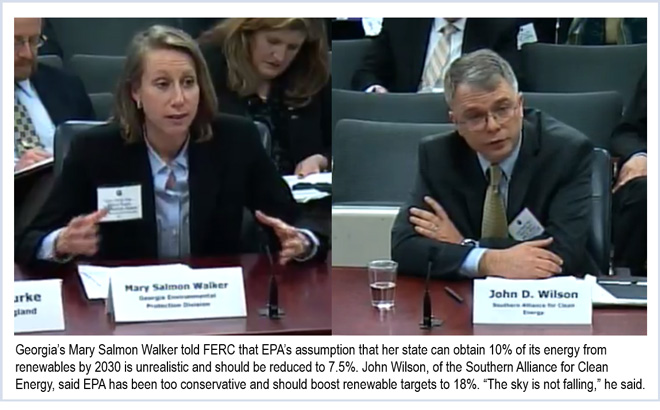By Rich Heidorn Jr.

Mary Salmon Walker, chief operating officer for the Georgia Environmental Protection Division, said the proposed rule fails to give her state credit for previous CO2 emission reductions or for Georgia Power’s Vogtle nuclear units 3 and 4, now under construction.
She also said EPA’s assumption that the state can obtain 10% of its energy from renewables by 2030 is unrealistic and should be reduced to 7.5%.
Georgia also opposes an alternative method for calculating state goals that EPA included in its Notice of Data Availability in October. The state says it would force an 83% reduction in fossil fuel generation from 2012 levels. (See EPA Signals Flexibility on Interim Carbon Targets, Coal-Gas Shift.)
Too Much, Too Soon
Paul Newton, North Carolina president of Duke Energy, said the EPA proposal is “too much too soon” and that the proposed interim targets would require North Carolina and Florida to meet more than three-quarters of their 2030 emission reduction requirements by 2020, resulting in billions in stranded assets.
The company said it has invested more than $7 billion on SO2 scrubbers and selective catalytic reduction technology that controls NOx emissions to bring its coal-fired generators into compliance with EPA regulations. “The EPA modeling of its proposed ‘preferred option’ shows a number of Duke Energy coal units shutting down by 2020. Duke Energy currently has no plan to retire the units the EPA modeling shows retiring,” Newton said.
Duke said EPA should eliminate the interim compliance period targets and allow states to develop their own “glide paths” to meet the 2030 targets. The North American Electric Reliability Corp. or its delegates should evaluate state implementation plans to help identify possible reliability problems before submitting them to EPA, the company said.
John Trawick, Southern Co.’s senior vice president for commercial operations and planning, said the company will have to negotiate four sets of state regulators, legislatures and environmental departments as Georgia, Alabama, Mississippi and Florida develop their implementation plans. “It’s a very challenging thing to deal with,” he said.
Sky is Not Falling
John D. Wilson, research director of the Southern Alliance for Clean Energy, offered a much sunnier picture. “I’m ‘the sky is not falling’ person here today,” he told the commission.
Wilson said the size of Duke, Southern and the Tennessee Valley Authority means they can meet the EPA requirements with “relatively modest” steps — increasing solar and wind power and improving planning and operational tools the utilities already use.
“EPA’s proposed Clean Power Plan will be flexible and, frankly, not challenging enough to merit alarm,” Wilson said.
The alliance cited studies that it says concluded an 18% renewable energy portfolio and state energy efficiency targets of at least 15% — rather than the roughly 10% savings assumed by EPA — are feasible.
“Wind- and solar-power market-development opportunities in the Southeast are at least 15 to 20% of total generation, several times greater than the 0 to 10% considered by EPA,” Wilson said. “Wind resources are available in-region; proposed HVDC transmission provides access to on-peak wind resources that will complement solar.”
Wilson conceded that compliance will be more difficult for smaller utilities with limited generation diversity. To help them comply, state regulators should support the establishment of credit or allowance markets, he said.
One of those smaller utilities is the Seminole Electric Coop., which supplies nine distribution cooperatives in 42 Florida counties.
James Frauen, vice president of technical services and development for Seminole, said the 38% carbon reduction EPA set for Florida would require retirement of more than 90% of the state’s coal-fired generation — including the 1,300-MW Seminole Generating Station, which generates 50% of the co-op’s power — most of them by 2020.
The co-op has invested more than $500 million on the plant, funded by long-term loans that represent more than three-quarters of its outstanding debt. It says it planned to run the plant, which it calls “one of the cleanest in the nation,” until at least 2045.
“None of the options are particularly good. It’s going to cost more,” said Frauen, who noted that the co-op’s rates are already higher than average because of its low population density. “We can get there, but certainly not by 2020.”
Florida’s Challenges
Florida has firm transmission to import only 2,800 MW of generation to serve its 52,000 MW of load. It also has no natural gas reserves, nor the geological formations to economically store gas underground.
“A substantial amount of coal-fired electric generation must remain in Florida to ensure some level of fuel diversity and the resulting reliability benefits,” Frauen said. “To remove more than 90% of coal capacity from Florida would obligate Florida to rely solely on ‘just in time’ inventory for nearly all of its fuel supply, with reliability consequences for any disruptions in the supply chain.”
(See related stories, FERC Seeking Its Role on Carbon Rule ‘Safety Valve’.)


